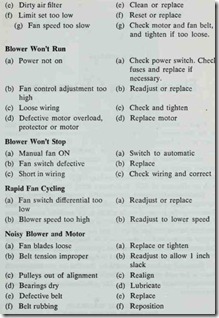MAINTENANCE AND OPERATING INSTRUCTIONS
The following recommendations are offered as a guide to the maintenance and operation of a coal-fired furnace:
1. Carry a deep or high fire by keeping the pot full. Let coals come up to the feed door and higher, and then slope back. Do not disturb the fire by frequent feeding in driblets, or poking or shaking through the day. Feed, shake or clear grate at regular intervals.
2. When feeding coal to the furnace or shaking the fire, keep the choke damper open and the draft door closed.
3. In severe weather, give the furnace most careful attention late at night. Clear the grate until it is bright underneath, and fill the pot full.
4. In mild weather (running with checked fire), feeding the fire in the morning and at night is usually enough. In ex treme weather, it may be necessary to feed more often.
5. Do not leave the feed door open in order to check the fire (in mild weather or at night). Correct adjustment of the damper control will regulate the fire to supply just the right amount of heat needed.
6. Do not allow ashes to bank up under the grate in the ash pit. Grate bars are hardy, but it is possible to warp them by carelessness. Taking up ashes once a day is the best rule, even if few ashes have fallen into the pit. If con venient, spray the ashes with a water hose before taking them up.
7. Keep the heating surfaces and flues clean. Soot will reduce heating efficiency and the furnace will require much more fuel to produce the required heat than would be the case if it were clean.
8. Do not overshake or poke the fire in mild weather. Shake it enough to make room for a little more fuel. Never poke a hard coal fire from above.
9. Clean the fire regularly especially in cold weather. This will result in fuel savings and increased heating efficiency. Do not slice or poke the fire from the top. Use the feed door for removing large clinkers. Do all cleaning through the clinker door, or by shaking the dumping grate.
10. If the fire does not burn evenly over the entire grate or if it seems sluggish in starting up after the grates have been thoroughly shaken, a thorough cleaning is required. This is accomplished by allowing the fire to burn down until a thin layer of fuel is left on the grate. Shake well and re move all the slate and clinkers left on the grate with a slice bar and hoe. To start the fire, first add a thin layer of fresh coal and feed the full charge of fuel only after this layer is burning briskly.
11. The grate will sometimes get covered with slate and clink ers massed together when a poor quality coal is burned. The best way to correct the situation is to dump the grate and build an entirely new fire.
12. Hard clinkers lodged between the grate bars should be re moved with a poker or slice bar.
TROUBLESHOOTING A COAL-FIRED FURNACE
The list that follows contains the most common operating prob lems associated with coal-fired furnaces. Each problem is given in the form of a symptom, the possible cause, and a suggested remedy. This list is intended to provide the operator with a quick reference to the cause and correction of a specific problem.


